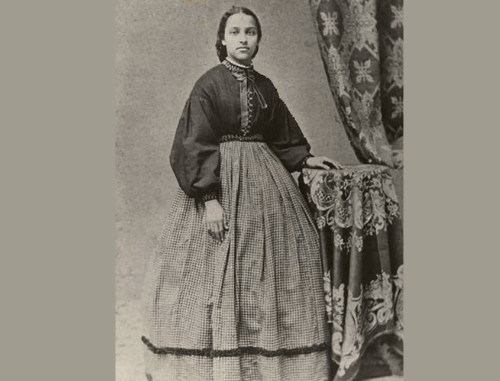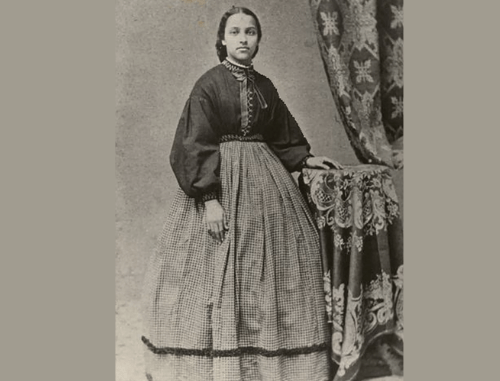Register for FY25
Full-Year Financial and Programmatic Results
Mary Jane Patterson: First Black Woman to Obtain a Bachelor's Degree


Mary Jane Patterson was a woman with a strong, forceful personality, and showed tremendous power for good in establishing high intellectual standards in the public schools.” - Mary Church Terrell
February 14, 2022
I want to continue my tribute to Black women who made a difference by honoring Mary Jane Patterson. Because I believe that education is a pathway to economic well-being, I am especially moved by her contributions and how she paved the way for women of color to expand their educational dreams.
In 1862, a young woman stood at a podium at Oberlin College and gave a graduation address. This was remarkable —not only because she was a woman, but because she was the first Black woman known to have earned a bachelor’s degree.
Mary Jane Patterson was a young African American woman from North Carolina, born into slavery in 1840. When she was a young girl, Ms. Patterson and her family moved to Oberlin, Ohio—it’s unclear if her father, a master mason, escaped slavery or was freed by his master. At the time, Oberlin was a haven for African-Americans. Home to a large Black population, it was known as an abolitionist town and one that regularly protected fugitive slaves. Oberlin College had admitted African-American students since 1835.
In the mid 1850s, when Mary Jane Patterson was around 17 years of age, she started her collegiate education at Oberlin College. Black students had graduated from the school, but without a four-year collegiate bachelor’s degree. Ms.Patterson changed that. And, although Oberlin offered a two-year course for women, she insisted on taking the “gentleman’s course” of study. She went on to graduate in 1862, as the first woman of color to graduate from a four-year bachelor’s program.
Upon receiving her degree she went to Philadelphia where she taught in the "Institute for Colored Youths" for seven years. In 1869 she went to Washington to teach and in 1871 became the first Black principal of the newly-established Preparatory High School for Negroes. She became the school’s first African-American principal. During her administration, the school grew from less than 50 to 172 students, the name "Preparatory High School" was dropped, high school commencements were initiated, and a teacher-training department was added to the school.
Ms. Patterson's commitment to thoroughness helped her establish the school's strong intellectual standards. Mary Jane Patterson died at her Washington, D. C. home, September 24, 1894, at the age of 54. Although she is a not well-known figure, Mary Jane Patterson was a pioneer in Black education and paved the way for other Black female educators.
Mary Jane Patterson era una mujer con una personalidad fuerte y contundente, y mostró un tremendo poder para bien en el establecimiento de altos estándares intelectuales en las escuelas públicas". - Mary Church Terrell
14 febrero 2022
Quiero continuar mi tributo a las mujeres de Color que hicieron una diferencia al honrar a Mary Jane Patterson. Debido a que creo que la educación es un camino hacia el bienestar económico, me conmueven especialmente sus contribuciones y cómo sentó las bases para que las mujeres de color expandieran sus sueños educativos.
En 1862, una joven se paró en un estrado en el Oberlin College y dio un discurso de graduación. Esto fue notable, no solo porque era mujer, sino porque fue la primera mujer de Color que se sabe que obtuvo una licenciatura.
Mary Jane Patterson era una joven afroamericana de Carolina del Norte, nacida en la esclavitud en 1840. Cuando era una niña, Patterson y su familia se mudaron a Oberlin, Ohio; no está claro si su padre, un maestro albañil, escapó de la esclavitud o fue liberado por su amo. En ese momento, Oberlin era un refugio para los afroamericanos. Hogar de una gran población de Color, era conocida como una ciudad abolicionista y una que protegía regularmente a los esclavos fugitivos. Oberlin College había admitido estudiantes afroamericanos desde 1835.
En medio de la Década de 1850, cuando Mary Jane Patterson tenía alrededor de 17 años, comenzó su educación universitaria en Oberlin College. Los estudiantes afroamericanos se habían graduado de la escuela, pero sin una licenciatura universitaria de cuatro años. La Srita. Patterson cambió eso. Y aunque Oberlin ofrecía un curso de dos años para mujeres, ella insistió en tomar el "curso de caballeros" de estudios. Se graduó en 1862, como la primera mujer de color de graduarse de un período de cuatro años en un programa de licenciaturas.
Al recibir su título, se fue a Filadelfia, donde enseñó en el "Institute for Colored Youths" durante siete años. En 1869 fue a Washington a enseñar y en 1871 se convirtió en la primera directora de color de la recién establecida Preparatory High School for Negroes. Se convirtió en la primera directora afroamericana de la escuela. Durante su administración, la escuela creció de menos de 50 a 172 estudiantes, se eliminó el nombre de "Preparatory High School", se iniciaron las ceremonias de graduación de la escuela secundaria y se agregó un departamento de capacitación para maestros de escuela.
El compromiso de la Srita. Patterson con el esmero le ayudó a establecer los altos estándares intelectuales de la escuela. Mary Jane Patterson murió en su casa de Washington, D.C., el 24 de septiembre de 1894, a la edad de 54 años. Aunque es una figura no muy conocida, Mary Jane Patterson fue pionera en la educación de los afroamericanos y sentó la bases para otras mujeres educadoras de color.
-min.avif)


